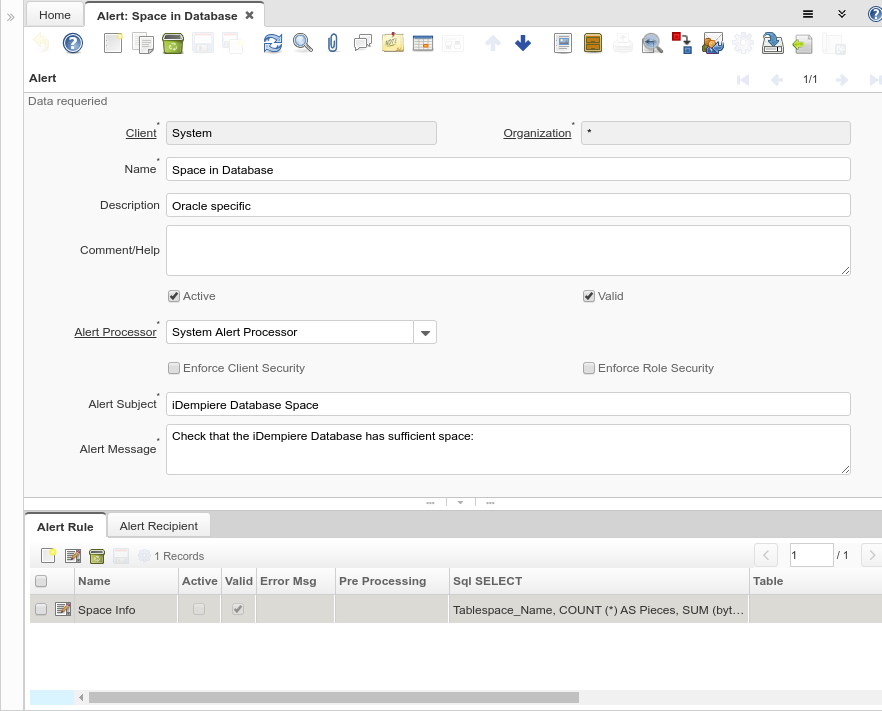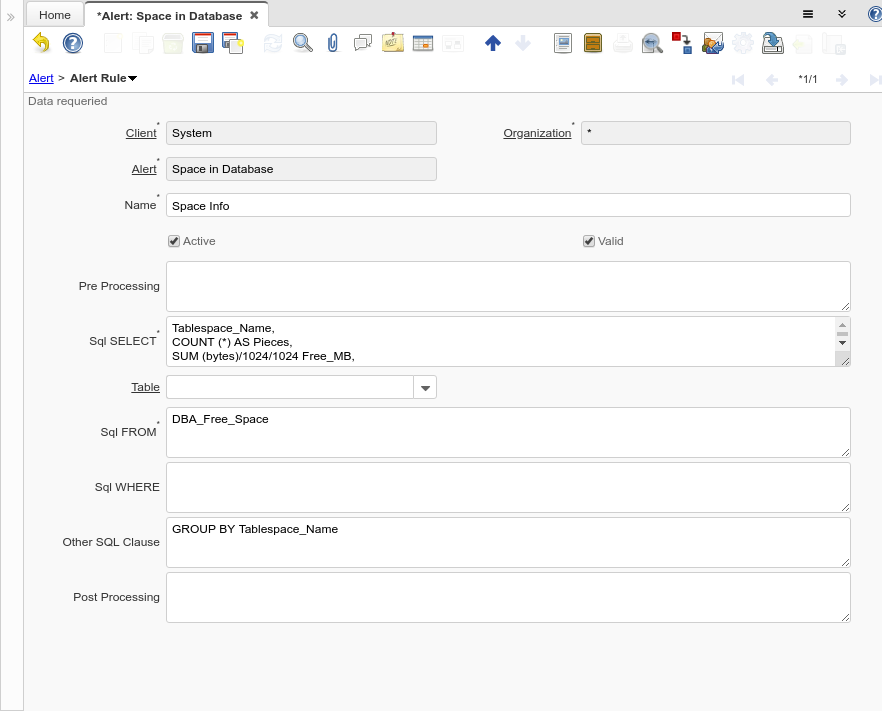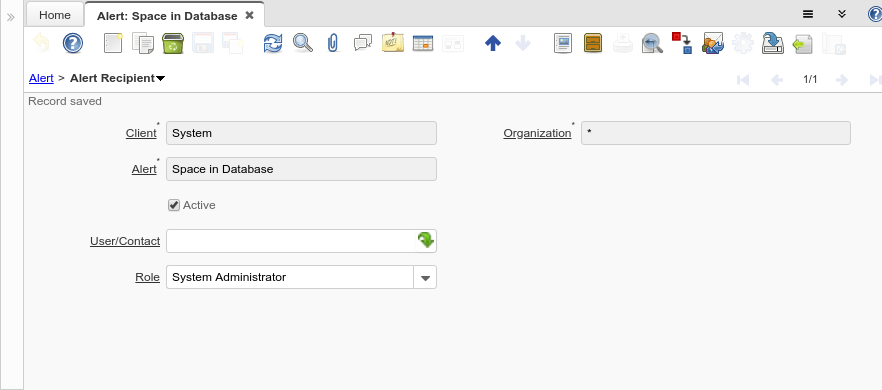Alert (Window ID-276)
Window: Alert
Description: iDempiere Alert
Help: iDempiere Alerts allow you define system conditions you want to be alerted of
Tab: Alert
Description: iDempiere Alert
Help: iDempiere Alerts allow you define system conditions you want to be alerted of.
| Name | Description | Help | Technical Data |
|---|---|---|---|
| Tenant | Tenant for this installation. | A Tenant is a company or a legal entity. You cannot share data between Tenants. | AD_Alert.AD_Client_ID numeric(10) Table Direct |
| Organization | Organizational entity within tenant | An organization is a unit of your tenant or legal entity - examples are store, department. You can share data between organizations. | AD_Alert.AD_Org_ID numeric(10) Table Direct |
| Name | Alphanumeric identifier of the entity | The name of an entity (record) is used as an default search option in addition to the search key. The name is up to 60 characters in length. | AD_Alert.Name character varying(60) String |
| Description | Optional short description of the record | A description is limited to 255 characters. | AD_Alert.Description character varying(255) String |
| Comment/Help | Comment or Hint | The Help field contains a hint, comment or help about the use of this item. | AD_Alert.Help character varying(2000) Text |
| Active | The record is active in the system | There are two methods of making records unavailable in the system: One is to delete the record, the other is to de-activate the record. A de-activated record is not available for selection, but available for reports.
There are two reasons for de-activating and not deleting records: (1) The system requires the record for audit purposes. (2) The record is referenced by other records. E.g., you cannot delete a Business Partner, if there are invoices for this partner record existing. You de-activate the Business Partner and prevent that this record is used for future entries. |
AD_Alert.IsActive character(1) Yes-No |
| Valid | Element is valid | The element passed the validation check | AD_Alert.IsValid character(1) Yes-No |
| Alert Processor | Alert Processor/Server Parameter | Alert Processor/Server Parameter | AD_Alert.AD_AlertProcessor_ID numeric(10) Table Direct |
| Enforce Tenant Security | Send alerts to recipient only if the tenant security rules of the role allows | AD_Alert.EnforceClientSecurity character(1) Yes-No | |
| Enforce Role Security | Send alerts to recipient only if the data security rules of the role allows | AD_Alert.EnforceRoleSecurity character(1) Yes-No | |
| Alert Subject | Subject of the Alert | The subject of the email message sent for the alert | AD_Alert.AlertSubject character varying(255) String |
| Alert Message | Message of the Alert | The message of the email sent for the alert | AD_Alert.AlertMessage character varying(2000) Text |
Tab: Alert Rule
Description: Definition of the alert element
Help: The definition of the altert or action
| Name | Description | Help | Technical Data |
|---|---|---|---|
| Tenant | Tenant for this installation. | A Tenant is a company or a legal entity. You cannot share data between Tenants. | AD_AlertRule.AD_Client_ID numeric(10) Table Direct |
| Organization | Organizational entity within tenant | An organization is a unit of your tenant or legal entity - examples are store, department. You can share data between organizations. | AD_AlertRule.AD_Org_ID numeric(10) Table Direct |
| Alert | iDempiere Alert | iDempiere Alerts allow you define system conditions you want to be alerted of | AD_AlertRule.AD_Alert_ID numeric(10) Table Direct |
| Name | Alphanumeric identifier of the entity | The name of an entity (record) is used as an default search option in addition to the search key. The name is up to 60 characters in length. | AD_AlertRule.Name character varying(60) String |
| Active | The record is active in the system | There are two methods of making records unavailable in the system: One is to delete the record, the other is to de-activate the record. A de-activated record is not available for selection, but available for reports.
There are two reasons for de-activating and not deleting records: (1) The system requires the record for audit purposes. (2) The record is referenced by other records. E.g., you cannot delete a Business Partner, if there are invoices for this partner record existing. You de-activate the Business Partner and prevent that this record is used for future entries. |
AD_AlertRule.IsActive character(1) Yes-No |
| Valid | Element is valid | The element passed the validation check | AD_AlertRule.IsValid character(1) Yes-No |
| Error Msg | AD_AlertRule.ErrorMsg character varying(2000) Text | ||
| Pre Processing | Process SQL before executing the query | Could be Update/Delete/etc. statement | AD_AlertRule.PreProcessing character varying(2000) Text |
| Sql SELECT | SQL SELECT clause | The Select Clause indicates the SQL SELECT clause to use for selecting the record for a measure calculation. Do not include the SELECT itself. | AD_AlertRule.SelectClause character varying(2000) Text |
| Table | Database Table information | The Database Table provides the information of the table definition | AD_AlertRule.AD_Table_ID numeric(10) Table Direct |
| Sql FROM | SQL FROM clause | The Select Clause indicates the SQL FROM clause to use for selecting the record for a measure calculation. It can have JOIN clauses. Do not include the FROM itself. | AD_AlertRule.FromClause character varying(2000) Text |
| Sql WHERE | Fully qualified SQL WHERE clause | The Where Clause indicates the SQL WHERE clause to use for record selection. The WHERE clause is added to the query. Fully qualified means "tablename.columnname". | AD_AlertRule.WhereClause character varying(2000) Text |
| Other SQL Clause | Other SQL Clause | Any other complete clause like GROUP BY, HAVING, ORDER BY, etc. after WHERE clause. | AD_AlertRule.OtherClause character varying(2000) Text |
| Post Processing | Process SQL after executing the query | Could be Update/Delete/etc. statement | AD_AlertRule.PostProcessing character varying(2000) Text |
Tab: Alert Recipient
Description: Recipient of the Alert Notification
Help: You can send the notifications to users or roles
| Name | Description | Help | Technical Data |
|---|---|---|---|
| Tenant | Tenant for this installation. | A Tenant is a company or a legal entity. You cannot share data between Tenants. | AD_AlertRecipient.AD_Client_ID numeric(10) Table Direct |
| Organization | Organizational entity within tenant | An organization is a unit of your tenant or legal entity - examples are store, department. You can share data between organizations. | AD_AlertRecipient.AD_Org_ID numeric(10) Table Direct |
| Alert | iDempiere Alert | iDempiere Alerts allow you define system conditions you want to be alerted of | AD_AlertRecipient.AD_Alert_ID numeric(10) Table Direct |
| Active | The record is active in the system | There are two methods of making records unavailable in the system: One is to delete the record, the other is to de-activate the record. A de-activated record is not available for selection, but available for reports.
There are two reasons for de-activating and not deleting records: (1) The system requires the record for audit purposes. (2) The record is referenced by other records. E.g., you cannot delete a Business Partner, if there are invoices for this partner record existing. You de-activate the Business Partner and prevent that this record is used for future entries. |
AD_AlertRecipient.IsActive character(1) Yes-No |
| User/Contact | User within the system - Internal or Business Partner Contact | The User identifies a unique user in the system. This could be an internal user or a business partner contact | AD_AlertRecipient.AD_User_ID numeric(10) Search |
| Role | Responsibility Role | The Role determines security and access a user who has this Role will have in the System. | AD_AlertRecipient.AD_Role_ID numeric(10) Table Direct |



